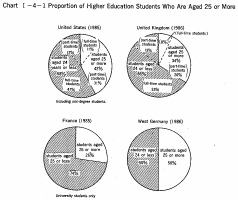| Home > Policy > White Paper, Notice, Announcement > White Paper > JAPAMESE GOVERNMENT POLICIES IN EDUCATION,SCIENCE AND CULTURE 1990 > PART |
||
After the end of World War ![]() , especially during the l960's
and l97O's, higher education in European and North American countries, as well
as in Japan, recorded a dramatic expansion. This expansion was a result of active
efforts to increase educational institutions and courses of study to cope with
the growing expectations of the public towards the role of higher education caused
by economic development and the rapid advancement of science and technology,
the growing aspirations of students for advancing to higher education in the
context of the improved level of people's standard of living, and an increase
in the higher education age group.
, especially during the l960's
and l97O's, higher education in European and North American countries, as well
as in Japan, recorded a dramatic expansion. This expansion was a result of active
efforts to increase educational institutions and courses of study to cope with
the growing expectations of the public towards the role of higher education caused
by economic development and the rapid advancement of science and technology,
the growing aspirations of students for advancing to higher education in the
context of the improved level of people's standard of living, and an increase
in the higher education age group.
In Japan total enrollment in universities, junior colleges and colleges of technology (the fourth and fifth years) has tripled since 1960. Total enrollments in these institutions and advanced courses at special training schools have quadrupled during the same period. In the other countries dealt with in this chapter, enrollments in higher education have recorded a dramatic increase during the past three decades: three times in the United States, three times in the United Kingdom, five times in France, five times in West Germany, and twice in the U.S.S.R.
This quantitative expansion in these countries has resulted in a vast scale of higher education, which each country has never witnessed before. An international comparison of the proportion of the age group entering higher education on a full-time basis shows that the highest proportion is found in the United States (44.3% in 1986), followed by Japan (36.8% in 1990 in terms of the proportion of the 3g8group advancing to universities, junior colleges and colleges of technology). The proportion is 23.9% in the United Kingdome (in 1986), 31.9% in France (in 1986), and 20.6% in West Germany (in 1986), The proportion in Japan would become higher if the proportion of students going on to advanced courses at special training schools is added (53.7% in 1990). In the United States and the United Kingdom, in addition to full-time students, there are many part-time students who engage in learning either for a few hours a day or for a few days a week. The proportion which these part-time students are to the age group is 17.6% in the United States and 2O.2% in the United Kingdom (as of 1986).
Regarding institutions of higher education other than universities, in Japan junior colleges, colleges of technology and special training schools have developed, while in the United States public community colleges have been expanding and in West Germany Fachhochschulen have been increasing. In these countries the proportion of total enrollments in these institutions offering short-term courses has been increasing. In the United Kingdom polytechnics and colleges of higher education have been developing as a vocationally oriented non-university sector. In France there is a number of grandes ecoles, small sized vocationally oriented institutions, which very often enjoy a higher, esteem than universities do. Thus institutions of higher education in each of these countries have been diversified.
A common characteristic of the recent changes in higher education
in the selected countries is that. as the scale of higher education has expanded,
adult students have been increasing and the age range of higher education students
has become much wider. Meanwhile the situation is quite different in Japan, where
97to 98% of university students have obtained university admissions within three
years after their graduation from upper secondary schools, and consequently the
age range of students is narrower than in the other selected countries. In the
United States and some other countries, in the context of the employment practice
whereby definite qualifications are valued, a great number of adults are enrolled
in part-time courses, and the number of students aged 25 or more account for
30 to 50 percent of all students. This fact indicates that institutions of higher
education in these countries play an important role in the lifelong learning
of the people. (See Chart ![]() -4-1.)
-4-1.)

The higher education systems in the selected countries with the above-mentioned scale and structures are now confronted with various issues, which differ from country to country. The following efforts are being made with a view to improving the quality of educational and research programs and ensuring better contributions of higher education to society: improving the content of courses, especially general education courses (in the United States); increasing the proportion of the age group advancing to higher education, securing better collaboration with the industry, and improving efficiency in education and research (in the United Kingdom): allowing more flexibility to course contents and securing quality teachers (in France); diversifying and individualizing institutions of higher education (in West Germany); and securing more democratic and more efficient administration and management of individual institutions (in the U.S.S.R.).
The subsequent sections will outline the higher education systems in each of the five selected countries and then observe admission procedures, educational programs, student life and the structure of administration and finance, with special reference to universities. This section will attempt a comparative analysis with regard to some of these topics.
| Back to Top | MEXT HOME |